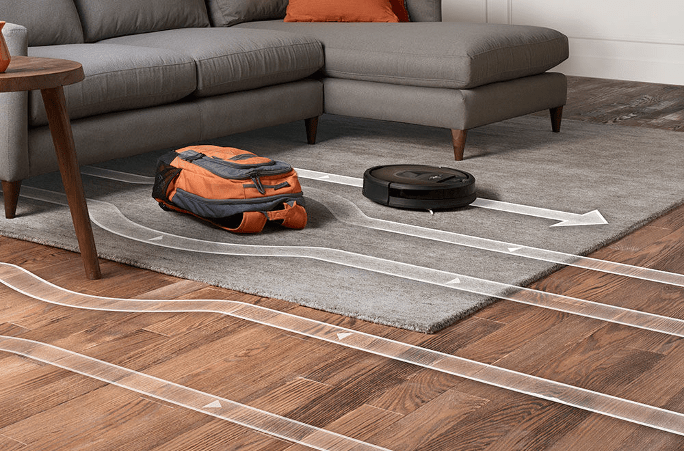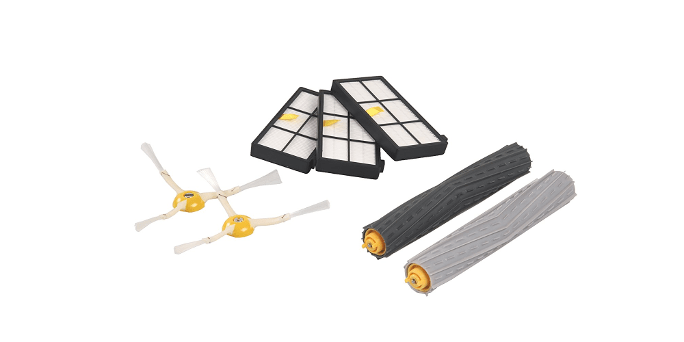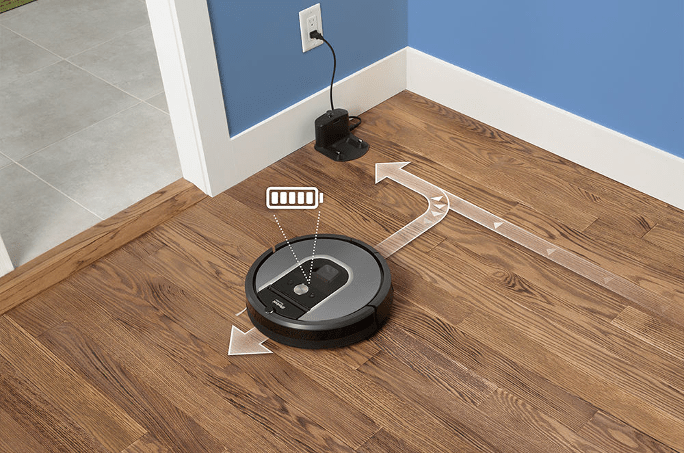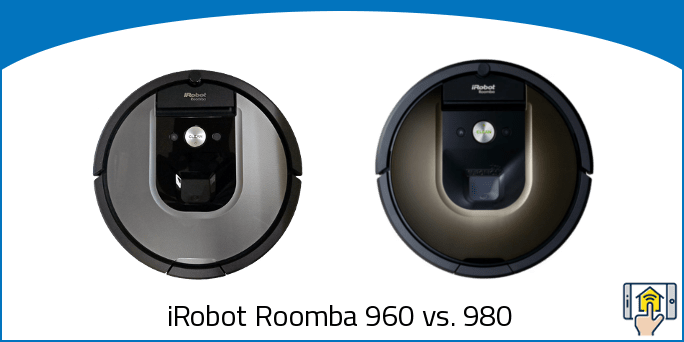Are you tired of spending time trying to cram a vacuum into the various nooks and crannies around your home? With a robot vacuum cleaner, you can say goodbye to hassle and hello to convenience when it comes to keeping your floors clean.
For around $100 more, the offers better performance on carpets and a better battery life. If the gap between the 960 and the 980 gets bigger than that, however, you might be better off with . (Check out the now.)
Below we’ll go into detail on the differences between the iRobot roomba 960 vs. 980 to help you get a sense of which vacuum is best for your home. While these models might not be the latest and greatest from iRobot, we’ve generally found that they’re the most reliable and effective at keeping your house clean. Feel free to skip ahead to any specific part of the article that interests you using the navigation bar below.
iRobot Roomba 960 vs. 980 — Things in Common
-
iRobot Home App – both Roomba models can hook into your home network — allowing you to control your vacuum remotely and customize it to your own preferences. Regardless of the model you choose, you’ll use the same app with the same features between the two as well. The smartphone app is available on both iOS and Android.
The app’s primary function is to manage your Roomba’s schedule as well as adjust your various preferences. One particularly useful feature is the option to vacuum more than once — allowing you to ensure your floors are absolutely spotless. Both Roombas use a navigation system in order to get a full map of your house and will only make one pass over each area during its scheduled cleaning. You can override that for two cleanings if you want to make sure you tackle every last dust bunny.
If you don’t happen to have a smartphone, you can control the Roomba without the app as well.
When you open the app, you’ll see an intuitive interface that should be pretty easy to decipher. There are several different menu options, and front and center is a huge “Clean” button, making it easy to pull out your app and set your Roomba to cleaning. The app will also let you know when the dustbin is full by displaying a giant red marker.
As far as other noteworthy options go, you’ll be able to choose your cleaning preferences, adjust the schedule, see the vacuum’s history, and keep an eye on the health of your Roomba — including an indication of when it’s time to clean out the debris extractors. You’ll also be able to view a useful map of where the Roomba has cleaned at the end of every session, allowing you to identify any missed spots.
Long story short, the app is easy to use and intuitive enough for even the most technologically-challenged among us.
-
Offline Use – We recommend connecting your 960 or 980 to your wireless network in order to better control it and access some of its features, but it’s actually possible to use your Roomba without connecting to WiFi.
Keep in mind, however, that you won’t be able to use any functions that require the iRobot Home app. More specifically, you’ll lose access to scheduled cleaning, the ability to prompt the Roomba to make two cleaning passes, and the carpet boost feature available only on the Roomba 980.
The offline use feature is useful in a pinch, but you’ll get much more use out of your Roomba if you hook it into your network. The scheduled cleaning is one of the most useful features of the smart vacuums, and losing access to that among other features is definitely noticeable.
-
On-board Camera – The on-board camera is the primary way that your Roomba will scan its surroundings and make intelligent decisions during its cleaning pass. It’s a low-res video camera that maps out your house, taking special note of various objects and obstacles and getting a general understanding of the layout of each room.
Because the Roomba’s camera is very low resolution and only used for general mapping, you won’t have to worry about your smart tech spying on you! The utility of the camera is great for intelligently mapping a room, but the features pretty much stop there.
In both the 960 and 980, there’s a small notch in the that points the camera forward and up. The Roombas will snap a picture of its location and use an algorithm to map out the most efficient path through the space.
As your robot cleans, it will scan the room and make note of any furniture, walls, or other obstacles. You shouldn’t have to worry too much about your Roomba getting stuck or lost, as it’s generally smart enough to keep itself on course.
-
Sensors – The main way that your Roomba 960 and 980 navigate around your home is through its sensors. The first is the onboard camera discussed above, and the other is a tracking sensor that keeps track of where the robot has already vacuumed. The combination of these two sensors allows the vacuum to learn the layout of your home. Over the coming days and months, your Roomba will learn more and more about your home, ensuring that each pass is more accurate and efficient than the last.
These Roomba models have come a long way from the original incarnation. The first Roomba models used a pretty random pattern when cleaning, while the 960 and 980 are much better about mapping out the most efficient path and only visiting each area once.
-
Recharges & Resumes – While your Roomba is pretty efficient when it comes to topping itself off at the end of every session, sometimes the vacuum’s battery might run low in the middle of a cleaning. Rather than continue moving around its map of your home, the robot cleaner will recognize that the battery is low and return to the dock to get a quick boost of power. This is called “mid-mission recharge” and lasts for 90 minutes. At the end of that period, your Roomba will get back to work cleaning your room — remembering right where it left off.
-
Brushless Mechanism – One feature that is unique to the 800 and 900 series of Roomba is the brushless cleaning mechanism. Traditional vacuums and older roombas use brushes in order to sweep up dirt into the bin. This is great at picking up dust, dirt, and pet hair, but maintenance can be a hassle. Every once in a while you’ll have to dig into the vacuum to unclog the brushes as they get tangled up in a mess of dust and hair, which is an arduous task that isn’t much fun at all.
Rather than using a brush to pick up dirt, the Roomba 960 and 980 use rubber rollers that beat and shake the dirt on the floor, sweeping it right up into the path of the suction. You shouldn’t have to worry too much about maintenance with either model. These vacuums are especially good for homeowners who have pets, as pet hair can be incredibly frustrating to pick out of traditional brushes. Suck up the hair from your furry friends without a care — letting your Roomba do all the work.
-
Edge-Sweeping Brush – While the Roomba doesn’t use a brush for the primary cleaning, both the 960 and 980 include an edge-sweeping brush that is perfect for cleaning along the wall. The vacuums have an algorithm that allows them to sweep those areas, getting into the hard-to-reach nooks and crannies and ensuring that you have a dust-free floor in every inch of your room.
Because the round, this side brush is a necessity to make sure it can pick up dust and dirt along those straight-lined obstacles.
The brushing is part of the Roomba’s three part cleaning process: agitate, vacuum, and suction. The rolls are really useful for the agitating step — far more than a traditional bristle-style brush rolls. These spinning brushes will sweep debris from the edges and corners of your room directly into the path of the central suction.
-
Anti-tangle Technology – You should try to keep your power cords out of the line of your Roomba, but the 960 and 980 are actually equipped with anti-tangle technology which should avoid wrecking your cords. It’s also useful for when the Roomba passes over tassels and carpet fringes.
We recommend trying to leave a clear path for your Roomba to work off of in case of any accidents, but it actually seems as if the vacuums do a pretty good job of avoiding damaging your cords, fringe, and tassels. It’s a cool feature that adds to the ability to “set it and forget it.”
For a closer look at how the technology functions, take a look at the video embedded below. It was made with an older model of Roomba, but the technology still functions the same with the current-day models.
-
No Falling – Your Roomba can map out a path of your home, but what if you want to use it in the bedrooms upstairs? Rest assured that your Roomba should avoid any accidental spills down a staircase due to cliff detection technology. If your vacuum encounters a ledge, it will correct its course and keep to cleaning on the current floor without catapulting itself down to disaster.
-
Can Roomba Clean Hardwood Floors? – The 960 and 980 actually do a very good job at cleaning hardwood floors. In testing, they managed to capture 100% of debris types that were tested. In addition to cleaning carpets, both vacuums are excellent at cleaning hard surfaces such as tile, hardwood, and laminate flooring. In fact, dust and debris is actually much easier to pick up off of hard flooring than it is carpeting, so you shouldn’t ever have to break out a traditional vacuum again!
iRobot Roomba 960 vs. 980 — Differences

-
Difference #1: Air Power – There’s a significant difference between the 960 and 980 in terms of air power. Since your Roomba relies on suction in order to pick up dirt, having twice the power could potentially make a huge difference in the vacuum’s ability to clean.
However, it’s worth mentioning that testing didn’t seem to show a 100% better cleaning ability in the 980, contrary to what you’d think giving the power differences. In fact, there didn’t seem to be a significant difference between the two when it came to sucking up dirt. If air power is the only reason you’re looking at the 980, we honestly don’t feel like it’s worth the significantly increased price.
-
Difference #2: Motor – The main reason that the 980 manages to have twice the air power is that it’s using a newer generation motor.
While the 960 has a bunch of upgrades that make it a superior choice when compared to older models, it’s actually still using the same motor that we saw with the 800 series. This means that the suction power isn’t significantly different, although it does generally do a better job of cleaning than the earlier models due to the updated technology that powers the vacuum.
The only downside to a more powerful motor is a louder sound. The 980 isn’t excessively loud by any means, but it’s definitely noticeably more noisy than the 960 and 800 series with their less powerful equipment.
-
Difference #3: Carpet Boost Mode – When your 960 is cleaning carpet, you might notice that it seems to struggle a little bit to move efficiently. This is because the carpet fibers are really good at trapping debris, and they also significantly reduce the suction force of the vacuum which makes it harder for it to get the dirt out.
The 980 doesn’t have as many issues with carpet due to its unique carpet boost technology. This is actually one of the most significant differences between the two models, and it makes a much bigger difference than the increased suction or newer motor. The increase suction when the 980 is passing over carpet really makes a big difference in its ability to pick up debris, and you may notice a significant difference between the two models if you have a lot of carpet in your home.
-
Difference #4: Battery Performance – Another difference between Roomba 960 and 980 is in the battery life. Although both Roombas have the ability to recharge in the middle of a cleaning session, the 980 can go for significantly longer before needing to top itself off due to the larger capacity of the battery.
Both vacuums run off of lithium-ion batteries, but the 960 has a 2130 mAh capacity while the 980 has a 3000 mAh capacity. In more practical terms, this means that the 980 has a working time of 120 minutes on a single charge while the 960 only manages 75 minutes.
While the larger capacity is definitely an advantage, it’s actually not that big of a deal in the grand scheme of things. Both vacuums are designed to be a hands-off experience, and both have the ability to recharge on your own. As you’re going about your day, you really shouldn’t notice a big difference between the two in their ability to get your floors clean. The 980 might get your floors clean a little bit faster, but do the time savings really matter when the Roomba is functioning on its own throughout the day? We don’t think so. Regardless of your choice, you’ll have floors that are free of debris by the end of the day — and that’s what really counts.
-
Difference #5: Virtual Wall Barrier – The 960 and 980 both intelligently map out your home and do a good job of keeping multiple rooms clean. However, you might run into a situation where you want to block your Roomba off from certain rooms. Fortunately, there’s a way to do so using a Virtual Wall Barrier.
These barriers use two AA batteries which come in the package when you purchase the Roomba, and can be used to block off certain areas that you don’t want your vacuum to access. The sensors can cover an opening of up to ten feet with Virtual Wall mode, or can create a circle with a diameter of 26” in Halo mode — perfect for keeping a certain spot within your room protected from the Roomba’s pathing.
The 980 comes with two barriers, while the 960 only ships with 1. This isn’t the end of the world as you can buy a Virtual Wall separately on Amazon and pretty easily add it into your home, but it’s nice that the 980 comes with a second by default.
-
Difference #6: Noise – Since the 980 does have a slightly larger motor, it is a little bit louder than the 960.
In most cases, a robot vacuum will be quieter than a traditional vacuum, so you shouldn’t have to worry too much about it interrupting your day. The 960 is actually one of the quietest vacuums on the market, but if you’re looking for a robot cleaner that’s even more silent you might want to look into an option like the Eufy RoboVac 11 or iLife A4s.
No products found.
iRobot Roomba 960 vs. 980 — Comparison Chart
| iAdapt | Yes, 2.0 | Yes, 2.0 |
| iRobot Home App | Yes | Yes |
| IR Remote Control | No | No |
| Recharge & Resume | Yes | Yes |
| Run Time | Up to 75 minutes | Up to 120 minutes |
| On-board Camera | Yes | Yes |
| Brushless Mechanism | Yes | Yes |
| Edge-Sweeping Brush | Yes | Yes |
| 3-Stage Cleaning System | 5x Suction | 10x Suction |
| Carpet Boost Mode | No | Yes |
| Virtual Wall Barrier | Comes w/ 1 | Comes w/ 2 |
| Virtual Wall Lighthouses | No | No |
| Avoids Stairs | Yes | Yes |
| Cleaning Schedules | Yes | Yes |
| Coverage Maps | Yes | Yes |
| Voice Control | Alexa, Google Assistant | Alexa, Google Assistant |
| Diameter | 13.8 inches | 13.8 inches |
| Height | 3.6 inches | 3.6 inches |
| Weight | 8.5 lbs. | 8.7 lbs. |
iRobot Roomba 960 vs. 980 — Accessories

All you really need to get your vacuum up and running is the package it comes in, but there are some accessories you might want to consider to keep your new Roomba operating at maximum efficiency.
First, we recommend looking into the Roomba 800 and 900 Series Replenishment Kit. It contains everything you need to maintain your vacuum for the foreseeable future, including multiple filters, side brushes, and rollers. Your Roomba shouldn’t need too much upkeep on a day-to-day basis, but with it cleaning every day it might need some pieces replaced every once in a while. Having the replenishment kit on hand keeps you well-prepared when the equipment starts to wear out.
If you’d prefer to purchase filters separately, you can buy 3 Replacement AeroForce High-Efficiency Filters for Roomba 800 and 900 Series 3 Replacement AeroForce High-Efficiency Filters for Roomba 800 and 900 Series. These are Hepa filters that ensure your robot vacuum won’t be kicking dust up into the air — perfect for those with allergies.
Since the 960 only comes with 1 Virtual Wall, you might want to add in another Dual Mode Virtual Wall Barrier. You can add in as many as you please, ensuring homes of any size should have complete control over the Roomba’s mapping.
Last but not least, the Integrated Home BaseIntegrated Home Base is an excellent option for keeping your Roomba charged. With easy access to a charging station wherever your vacuum happens to be, you should be able to maximize the cleaning efficiency with quick charging that can get your robot out and about as quickly as possible.
iRobot Roomba 960 vs. 980 — Our Thoughts

While both Roombas will do an excellent job of keeping your house clean, the 980 goes above and beyond with some extra features that make it worthy the buy.
It’s one of the best robot vacuums on the market — largely due to some useful utilities like the extra suction and ability to increase its power when it moves over carpet. It’s the perfect buy if you’re looking for a longer runtime, stronger motor, or extra virtual wall barriers.
No products found.
With that said, while it’s admittedly not as good at cleaning as the 980, you won’t be disappointed if you opt for the 960. It’s still one of iRobot’s top-of-the-line Roombas, and does a superb job of cleaning. It does struggle a little bit with carpet and won’t give quite as deep a clean when compared to the 980 due to the lower suction. The lower price certainly makes it an attractive option for buyers on a budget, however, so it’s important not to discount that advantage.
No products found.
Long story short, the is the superior model when comparing the iRobot Roomba 980 vs. 960. If you’re looking for a more affordable option, however, the is hot on its tail.
Last update on 2024-04-24 at 18:06 / Affiliate links / Images from Amazon Product Advertising API



